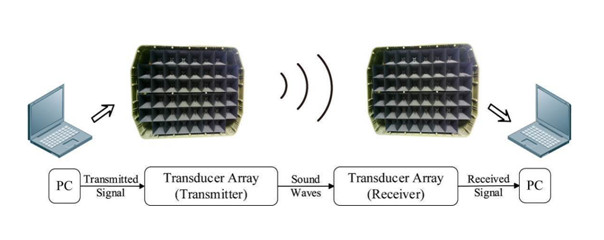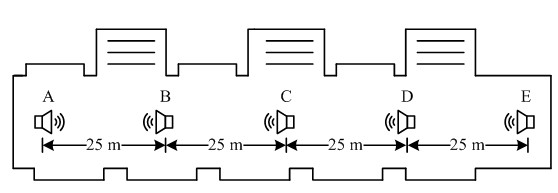Effectiveness of electromagnetic telecommunication is limited by Faraday shielding effects, and acoustic communication promotes the possibility of overcoming this problem. Conventional airborne wireless data transmission system is constrained for applications within the distance of ten meters. However, for long-range applications such as those found in electromagnetic shielding pipelines, saps, rooms or hallways, the adverse effects caused by background noise and reverberation can degrade the performance of acoustic communication.
The main conundrum limiting the transmission range of acoustic communication is the impedance mismatch with air. Sound wave intensity attenuates greatly as distance to the source is increased.
Researchers from the Institute of Acoustics of the Chinese Academy of Sciences have proposed an acoustic data transmission system, sound wave information of which can be transmitted over a considerably long distance expanded to hundreds of meters.
Using horn loudspeakers array allows an effective acoustical match between the diaphragm at the narrow end of the horn loudspeaker and the air to be achieved. With signal detection and amplifying circuits, sensitivity and reliability of the whole system are further enhanced.
To make the prototype of the entire system more versatile in use, system hardware complexity plays an important role. Both the simulation signals and the off-line signals are processed on personal computers for testing the performance of the system. Notebooks are used as central controllers, as well as playing and recording sound.
Information is encoded and played via PC soundcard. Amplified by loudspeaker array, signals with information are sent out as audible waves. In the receiving terminal, these audible waves are recorded, and then filtered by single-carrier frequency domain equalizer. Estimation of information is obtained after decoding. With extra degree of redundancy under certain schemes, error control of the system becomes more effective.
Measurements are carried out along a long hallway exceeded 100 meters from the Dah-You Maa Building of the Institute of Acoustics of the Chinese Academy of Sciences. Reflections from doors, windows, stairs, etc. will make the acoustic data transmission a much more complex circumstance. The received transducer array is tested for a range of distances every 25 meters away from the transmitted transducer array.
Monte Carlo test for each case is repeated three times and their average is calculated and used as the final result. Error performance of the system degrades as symbol rate is increased. As M is increased, i.e. from 16-QAM to 64-QAM modulation, BER (bit error rate) also increases accordingly for a given value of symbol rate.
It’s also observed that if the received signal amplitude is large enough, BER is not increased as the distance between the transmitter and receiver is increased. Consequently, the system performs well for different distances up to a hundred meters and can reach a maximum bit rate of 0.882 kbps.
Outdoor tests have also been carried out to evaluate the system performance. Considering the indoor test results, a 16-QAM modulation is chosen for the outdoor tests and the symbol rate equals 147 baud/s.
There are no obvious differences in the results for the different distances tested, ranged from 25 m to 100 m. The outdoor tests repeat in the same location from different time of the day, and in three days. The results differ significantly amongst various tests subjected to different wind conditions. The stronger the wind is, the higher BER will be. Tests are also carried out to test the performances for different baud rates and different signal amplitudes. Data of these different parameters obtained from three different days exhibit similar characteristics. Determining the relationship between wind conditions and system performance is for researchers' future work.

Fig. 1 System hardware configuration (Image by YU).

Fig. 2 Layout of long hallway test scenario (Image by YU).
References:
YU Ziying, KUANG Zheng, WU Ming and YANG Jun. Aerial Acoustic Communication for Long-Range Applications Based on Single-Carrier Frequency Domain Equalization. Proceedings of the 3rd IEEE China Summit & International Conference on Signal and Information Processing, The Third IEEE China Summit and International Conference on Signal and Information Processing (ChinaSIP 2015),
YU Ziying
Key Laboratory of Noise and Vibration Research, Institute of Acoustics, Chinese Academy of Sciences, 100190 Beijing, China
E-mail: yuziying@mail.ioa.ac.cn


